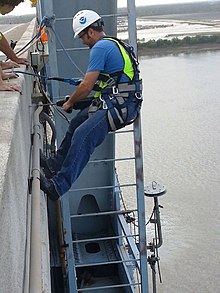| Revision as of 21:59, 11 September 2021 editWikiuser100 (talk | contribs)Extended confirmed users, Pending changes reviewers62,456 edits IdTags: Mobile edit Mobile web edit Advanced mobile edit← Previous edit | Revision as of 22:00, 11 September 2021 edit undoWikiuser100 (talk | contribs)Extended confirmed users, Pending changes reviewers62,456 edits →Classifications: Gen’l cleanupTags: Mobile edit Mobile web edit Advanced mobile editNext edit → | ||
| Line 13: | Line 13: | ||
| ==Classifications== | ==Classifications== | ||
| Fall Protection Systems | '''Fall Protection Systems''' | ||
| There are four classes of fall protection systems:<ref>{{cite web| url=https://edgefallprotection.com/|title= fall protection }} Friday, 4 January 2019</ref>{{Failed verification|date=June 2020}} | |||
| Class 1 Body belts (single or double D-ring) are designed to restrain a person in a hazardous work position to prevent fall or to arrest a fall completely within 3 foot of movement (]). Amends must be made to keep the line rigid at all times. A harness should also be used.{{clarify|reason=contradictory|date=July 2019}} | Class 1 Body belts (single or double D-ring) are designed to restrain a person in a hazardous work position to prevent fall or to arrest a fall completely within 3 foot of movement (]). Amends must be made to keep the line rigid at all times. A harness should also be used.{{clarify|reason=contradictory|date=July 2019}} | ||
Revision as of 22:00, 11 September 2021
Equipment designed to protect from falling
A safety harness is a form of protective equipment worn by principally by a human that is designed to protect them from injury or death from falling. The harness is is usually fabricated from rope, braided wire cable, or synthetic webbing. It is attached securely to a stationary object directly by a locking device or indirectly via a rope, cable, or webbing and one or more locking devices. Some safety harnesses are used in combination with a shock-absorbing lanyard, which is used to regulate deceleration and thereby prevent a serious G-force injury when the end of the rope is reached.
An unrelated use with a materially different arresting mechanism is bungee jumping.
In North America, safety harnesses designed for protection against falls from heights in industrial and construction activities are covered by performance standards issued by the American National Standards Institute (ANSI) in the United States and by CSA Group (formerly known as the Canadian Standards Association) in Canada. Specifically, the standards issued are ANSI Z359.1 and CSA Z259.10. These standards are updated approximately every four to five years.
Though they share certain similar attributes, a safety harness is not to be confused with a climbing harness used for mountaineering, rock climbing, and climbing gyms.
Specialized harnesses for animal rescue or transfer, as from a dock to a vessel, are also made.
Classifications
Fall Protection Systems
There are four classes of fall protection systems:
Class 1 Body belts (single or double D-ring) are designed to restrain a person in a hazardous work position to prevent fall or to arrest a fall completely within 3 foot of movement (OSHA). Amends must be made to keep the line rigid at all times. A harness should also be used.
Class 2 Chest harnesses are used when there are only limited fall hazards (no vertical free fall hazard), or for retrieving persons such as removal of persons from a tank or a bin.
Class 3 Full body harnesses are designed to arrest the most severe free falls.
Class 4 Suspension belts are independent work supports used to suspend a worker, such as boatswain's chairs or raising or lowering harnesses.
Types
Safety harness types include:
- Seat belts.
- Child safety seats.
- Over-the-shoulder restraints used on roller coaster trains.
- A seat with a full-body harness such as used by fighter pilots.
- Diving harnesses as used by professional divers
Uses
Occupations that may involve the use of safety harnesses include:
- Window cleaner
- Theatrical fly crew member
- Construction worker
- Crane operator
- Bridge painter
- Lineman
- Rock climber
- Motorsport
- Scaffolder
- Sailing
- High ropes
- Bungee jumping
- Professional diver
See also
- Jackstay – Substantial line between two points used to guide or support
- Fall arrest – Equipment which safely stops a person already falling
- Lifeline (diving) – A rope connecting the diver to an attendant, usually at the surface
- Climbing harness
References
- Encyclopedia.com
- "ANSI / ASSP Z359 Fall Protection and Fall Restraint Standards". assp.org. American Society of Safety Professionals. Archived from the original on May 27, 2020. Retrieved June 4, 2020.
Purchase Our Z359 Standards
- "CAN/CSA-Z259.10-12 (R2016) - Standards Council of Canada - Conseil canadien des normes". scc.ca. Standards Council of Canada. Retrieved June 4, 2020.
- "fall protection". Friday, 4 January 2019
- "Fall Protection Information". Archived from the original on 2016-08-04. Retrieved 2017-03-17.
Jones & Bartlett. Fire Fighter Skills. 2nd ed. Boston, Toronto, London, Singapore: Jones and Bartlett Publishers, 2009. pp243–244. Print.
External links
This technology-related article is a stub. You can help Misplaced Pages by expanding it. |